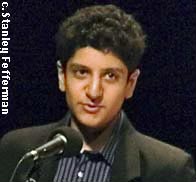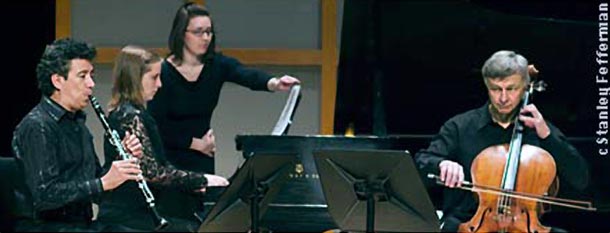 |
| The Amici Ensemble Hungarian Contrasts |
|
| April 6, 2008 • Glenn Gould Studio • Toronto |
|
|
|
|
|
|
| Report & photos by Stanley Fefferman |
| Amir Safavi was given a week to come up with a composition for clarinet, violin, and piano (a trio of instruments he was unfamiliar with); a composition that had to have a Hungarian flavour (also unfamiliar); a composition to fit in with a programme to be performed by the Amici Ensemble that included pieces by Bartok, Kodaly, and Dohnanyi (whose works Safavi would have to research and study). Fortunately for this talented, prize-winning and plucky young music student at the University of Toronto Schools, the week he was given for this daunting task was the week of March Break, and it provided him with all the time he needed.
“Hungarian Impressions for clarinet, cello and piano” received its world premier this afternoon with Amici’s Joaquin Valdepenas and David Hetherington (clarinet and cello) and guest pianist Orli Shaham. The piece consists of a series of small ‘portraits’ of that musical culture which Safavi was able to absorb, during his brief study of the modes of Hungarian and Gypsy music. My impression was of strongly melodic lines alternating between wistful sadness and dance to a wild climax, recalling through the clarinet a sound familiar from ‘klezmer’ music, with a nice innovation of having Hetherington drum with his fingers on the body of the cello.
|
| The other trio for violin, clarinet and piano on the programme was entitled “Contrasts”, and was also written under some pressure and also required the composer to immerse himself quickly in an unfamiliar musical tradition. The composer was Bela Bartok. In 1938, in Hungary, Bartok received a commission from Benny Goodman for a trio that would fit on two sides of a 78 rpm record. Bartok managed it as Hungary was slipping into the Nazi Axis. One year later, Bartok and his wife fled to New York, where he expanded his composition beyond the boundaries of a ‘78’ to a three movement work that incorporated his immersion in the work of Benny Goodman, Teddy Wilson, Gene Krupa, Gershwin, the Blues, and Balinese Gamelan. Like a lot of Bartok, the piece is creepy, eerie, spooky, jumpy, dramatic and very impressive. |
|

Amir Safavi |
|
| Amici’s cellist David Hetherington was joined by guest violinist Jonathan Crow for a sparky collaboration on Zoltan Kodaly’s “Duo for Violin and Cello, Op.7” (1914). The work is in the form of two dialogues, played parlando, and a dance. The dialogues are sequences of imitative passages where one instrument speaks a musical line while the other plucks a kind of bass-line rhythm, and then they alternate roles. The resulting effect is by turns playful, dramatic, exotic (in oriental modes), often dark, sometimes quite stressed, and allows for astonishing shifts in colour and texture. The final dance movement resolves these complexities in a display of some lovely Hungarian folk melodies that Kodaly collected and championed in his music.
Teng Li, the TSO’s principal viola, and Peter Seminov, the newly appointed first violin of the TSO, joined guest pianist Orli Shaham and Amici regulars Valdepenas and Hetherington for Dohnanyi’s celebrated “Quintet for Piano and Strings in C Minor, Op.1” The group gave a large symphonic sound to the first movement of this rich Brahmsian arrangement of passionate, and in passages — tragic music. The mood lightened during the scherzo, though the vivid colouring remained. The adagio brought out a plaintive, nostalgic character with a soothingly fluid wavelike flow. The closing allegro was almost gay. Ms Shaham’s piano sometimes bubbling along with the strings and in passages placing blocks of strong chords like rocks in a stream or boulders reinforcing the banks as the movement bobbed and rollicked to a close.
|
 |
|
|
|
|
|
|
| Stanley Fefferman is a writer/photographer on the Toronto music scene and elsewhere. His work appears online at www.showtimemagazine.ca and here at The LMR. |
|
|



